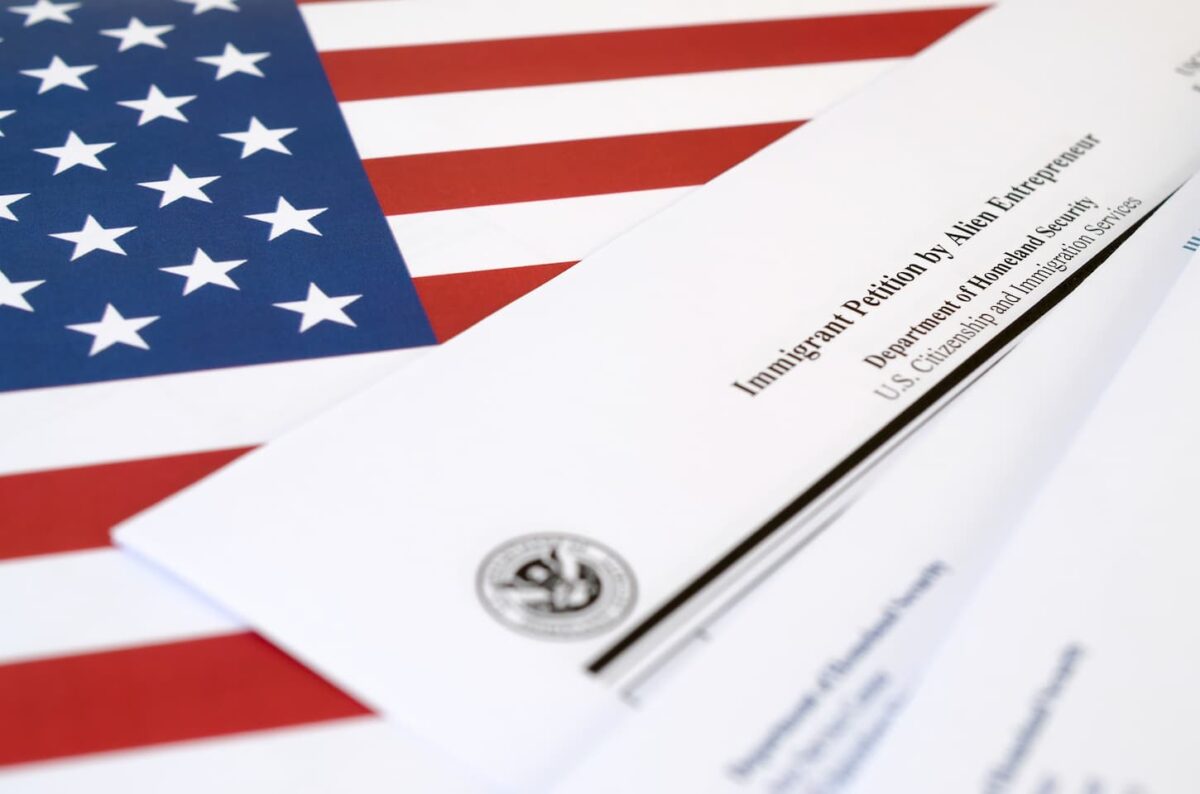Most people have an immigrant ancestor who changed their name once they arrived in America. The whole name-changing idea remains a little bit confusing, even to this day. How often did immigrants change their names? It wasn’t all the time.
Immigrants often changed their names when they came to America, though not always. Reasons for a name change include optional or enforced assimilation to a new country, the opportunity for a higher-paid job, and avoiding discrimination.
Researchers found that immigrants with names that were hard to pronounce would usually change them. They were people from Southern, Central, and Eastern Europe. How do we discover when and why our immigrant ancestors changed their names? Let’s dig into it.

Did Immigrants Change Their Names?
Immigrants did change their names for many reasons. Some of them wanted to leave the past behind and start over or wanted to fit in more easily in the new environment.
Around twelve million people arrived in the United States at Ellis Island in the late nineteenth century.
Ellis Island was the central processing center for immigrants from 1892 to 1954. The immigration inspectors weren’t responsible for registering the names. The names came from the ships’ checklists. Because of that, most likely, all the names were documented correctly.
Once the immigrants finally arrived in the United States at Ellis Island, they had the checklists with them. The immigration inspectors would ask them specific questions to verify their identity.
After the verification, the inspector would check the person off the list and allow them to enter the country.
So, what does this mean? It means there was no way the immigrants spelled their name wrong or changed it right away. Instead, what happened was the immigrants usually changed their names before coming to America.
The only thing that mattered was correctly answering all the questions to verify their identity. Another very fascinating thing is that the immigrant inspectors were multi-lingual and had translators. So, there was no way the inspectors changed the names.
From today’s point of view, we tend to believe the immigration process was chaotic and disorganized. The complete opposite is the truth. In the golden years of immigration to America, the process was smooth and fairly well organized.
The process of immigration to America
How did the entire immigration process happen? Generally, a person would buy a ticket for the ship to the United States with their own money, or a family member or friend would send the money from the United States.
To get the ticket, they needed travel documents. Depending on the country, they were written in different languages and alphabets.
These documents had to be translated correctly so the ship personnel could accurately prepare the checklist. Any change could be made at this stage, but it was done before the ship sailed.
Once they arrived in Philadelphia, Boston, New York, or any other U.S. Ports of Entry, then changing their name was possible once they set foot in the city. Nevertheless, the naturalization certificate had information about their original name and the necessary evidence of arrival in the U.S.
As we can see, the immigration process was very well organized and “by the book.” The legend of people changing their names at Ellis Island still lives, thanks to pop culture and family lore.
Did Immigrants Have Their Names Changed?
Immigrants did have their names changed after they settled into their new homes, usually a couple of years after their arrival. Alternatively, they changed their names before they left their homeland (frequently Europe).
Most immigrants didn’t change their names at Ellis Island. Rather, most immigrants did that much later. The reasons for changing names varied. Most of them liked the idea of the Americanization of their name as a good sign of assimilation into a different culture.
During the naturalization procedure, documentation for changing names was required after 1906, when Congress made that decision. This made the whole citizenship process much easier.
Do you need help finding an ancestor who changed their name? Please read this article: How to Find an Ancestor Who Changed Their Name.

Why Do Descendants of Immigrants Often Change Their Family Name?
The descendants of immigrants often change their names to sound more American so they will assimilate into the new environment and culture more easily.
The children of immigrants usually completely change their name, or they shorten it. But most of them decide to Americanize their original name. For example, if a French immigrant has the last name Blanc, they could change it to White.
Changing a name makes life easier in a social and economic sense. The reality is that children of immigrants often feel divided between cultures.
The immigrant parents try very hard to have a good life in a new country and accept new cultural habits—while at the same time, they try to preserve their own identity and traditions. The acculturation process is very complex, so the children usually feel confused.
The children are encouraged to learn a new language and cultural norms and to be independent. At the same time, they have to value their native roots and traditions.
For this reason, children can change their family name. Some of them change their first name, and some of them change their last name. This way, they create a balance between the old and the new and are more in touch with their identity.
Why Did People Change Their Names in the 1800s?
People changed their names in the 1800s to get better-paying jobs. At that time, immigrants were often discriminated against and stereotyped. A name that sounds more American could land them a better job.
In the 1800s, many people immigrated to the United States. Around twelve million people left their homes for a better life across the ocean.
Some fled from religious or political persecution, and some fled because of famine and high taxes. The United States was a country of promised opportunities and new chances.
In the 1870s, most immigrants were from Ireland, Germany, and England. Usually, they were offered land in a state where the population was scarce, or they were offered low-paying jobs.
The immigrants who changed their names to sound more American would frequently get better-paying jobs and higher positions. This meant better socioeconomic status and easier integration into the new culture.
Why Was the O Dropped From Irish Names?
Many Irish immigrants dropped the prefix “O” or “Mc” from their surname to escape discrimination. It wasn’t easy to find a job if someone had an Irish name.
We’re simplifying a lot of history and nuance, but it all started in the early 1600s when the O and Mc were dropped during the time of the oppression of the Catholic Church. So it was hard to find work with an Irish-sounding name.
Anti-Irish sentiments continued in America. So Irish immigrants Americanized their surnames by dropping the O or Mc to escape that prejudice. There were two main waves of Irish immigration to America.
- The first wave was from 1715 to 1845. The majority of Irish immigrants settled in Boston. They fled Ireland due to droughts, poor harvests, and oppression back home, including via tithe payments.
- The second wave was from 1845 to 1914, known as the Irish Potato Famine era. Due to progressive potato crop failures, people could no longer survive in Ireland.
In Ireland, they were farmers, but in America, the situation was different. They could not offer their farming skills because Americans had an advanced level of farming which they were not familiar with. So, they mostly settled in New York and Boston. The Irish men usually worked at the docks, cleaned stables and streets, and did other low-paying and hard jobs. The Irish women worked in factories or as servants.
At that time, the Irish weren’t well-beloved. Understandably, they spoke primarily Irish (Gaelic), most of whom were illiterate, and they were seen as a threat to “Americans’ jobs” because they would take the factory jobs for less pay than people who’d been in America longer (or were already citizens). Sometimes they took jobs for less pay intentionally, but often they were taken advantage of because they were illiterate or unable to speak English.
Most Irish immigrants lived in attics or basements without daylight, water, or sanitation. They changed their names by dropping the letter O or Mc to change their fortune in their new life. Irish family names that began with these letters were an obvious indication of being Irish.
In the late nineteenth century, it began to be less and less problematic to have Irish ancestry. As such, the prefixes O and Mc revived with the rebirth of national awareness. Today, millions of people in the United States have Irish ancestry.
Nowadays, we take pride in our Irish heritage, but the situation was different back then.

Why Did German Immigrants Change Their Names?
German immigrants changed their names for two reasons: the intentional Americanization and the unintentional phonetical spelling of their names.
So, how does this story go? German immigrants in Rotterdam boarded ships to the United States. On the ship, the staff had difficulty writing down German names, so they wrote the names as they heard them (phonetic spelling).
But, once the immigrants arrived in the United States, they were not obligated to use those misspelled names. The German immigrants likely didn’t even remember in what shape or form their names were written down. After all, most of them could not read.
Regarding the German names being changed, things were a little bit complicated, but a couple of reasons behind the name changes can be explained.
Anglicized spelling pronunciation (Americanized)
Let’s explain this with an example of the letter z. In American English, the letter z is pronounced the same as z (but our Canadian neighbors call it “zed.”). But in German, the letter z is pronounced with the sound ts, as in Zimmerman, Ziegler, or Schmelzer.
Here is another great example of names that begin with letters spoken in the German language but are silent in English. In German, “Knobloch” is pronounced with a k, but in English, the k is silent.
Specific language characters
The German language has specific characteristics that English doesn’t have. For example, the β in German is used to voice a sharp s. Because the English language doesn’t use the character β, Americans thought it was the letter b, and who wouldn’t think that?
Then we have the so-called umlauts. Bear with me – umlauts are German symbols that symbolize vowel sounds. Remember letters with the small dots above them? Those are umlauts. Letters such as ä, ö, and ü aren’t used in the United States. Once the German immigrants arrived, they had a couple of options to choose from:
- Adding an e. For example, the German name Müller became Mueller.
- Using umlauts but without the dots. For example, Jäger became Jager. This, of course, led to a different pronunciation of the name.
- Using the umlaut: for some, this worked perfectly fine, but for some, not so much. For example, the ü became ii, and the name Müller became Miiler. And let’s face it: Miiler likely became Miller.
Key Takeaways and Next Steps
Many immigrants changed their names once they arrived in the United States. For so many Americans, this is a part of their history. America was a promised land; they wanted to fit in and have a better life for themselves and their children.
Our names are important in our identity—they carry our cultural and family heritage. Changing a name can be a powerful statement of the new independence and freedom. New names made the integration process for immigrants much smoother and easier, especially for their children.
We hope you enjoyed reading this article. If you have any further interest in your ancestry, here are a few articles to get you started:
- Ancestry: How Far Back Do Records Actually Go?
- How To Find An Ancestor Who Disappeared: 29 Tips to Get Started
- How To Find Out Where an Ancestor is Buried: Complete Guide
- 20 Ways to Find Your Family Tree for Free
- When Did Your Ancestors Come to America? Let’s Find Out!
They’re all great resources – and a great way to help you in your genealogical journey.
Resources
When learning about genealogy, it’s important to learn from various reputable sources. These are the sources used in this article and our research to be more informed as genealogists.
- An introduction. (n.d.). http://www.irishidentity.com/lists/introduction.htm
- Ault, A. (2016, December 28). Did Ellis Island Officials Really Change the Names of Immigrants? Smithsonian Magazine. https://www.smithsonianmag.com/smithsonian-institution/ask-smithsonian-did-ellis-island-officials-really-change-names-immigrants-180961544/
- Brandslet, S. (2018, June 5). Name change in the United States brought economic payoff. Norwegian SciTech News. https://norwegianscitechnews.com/2018/06/name-change-united-states-economic-payoff/
- Burdess, N. (2016, October 25). A dozen things you might not know about Irish names. The Irish Times. https://www.irishtimes.com/culture/books/a-dozen-things-you-might-not-know-about-irish-names-1.2842791
- Cox, E. (2021, November 7). A little knowledge will take you a long way in Irish research. Emma Cox Genealogy. https://emmacox.co.uk/guest-post-a-little-knowledge-will-take-you-a-long-way-in-irish-research/
- Doppelt, J. (2016, June 11). Do immigrants change their names more than others and more than they once did? | Immigrant Connect. https://immigrantconnect.medill.northwestern.edu/blog/2016/06/11/do-immigrants-change-their-names-more-than-others-and-more-than-they-once-did/
- German Marylanders – Family Name Changes. (n.d.). https://www.germanmarylanders.org/miscellaneous-a-to-z/family-name-changes
- Gonnot, J. (2022, December 6). What’s in a name? Immigrant’s name choices as a signal of belonging. MPC Blog. https://blogs.eui.eu/migrationpolicycentre/immigrants-name-choices-signal-belonging/
- I. (2020, March 23). “Leaving Off the ‘O’”: Insights into Irish Emigrant Name Changes in 1860s America. Irish in the American Civil War. https://irishamericancivilwar.com/2019/06/27/leaving-off-the-o-insights-into-irish-emigrant-name-changes-in-1860s-america/
- Immigrant Name Changes. (2020, July 29). USCIS. https://www.uscis.gov/records/genealogy/genealogy-notebook/immigrant-name-changes
- Irish last names: the Mac & O; the evolution of surnames in Ireland. (n.d.). https://www.irish-genealogy-toolkit.com/Irish-last-names.html
- L. (2023, January 2). You Suspect Your Ancestor Changed His Name – Now What? Are You My Cousin? https://lisalisson.com/you-suspect-your-ancestor-changed-his-name-now-what/
- Strom, A. (2022, August 27). Names, Identity, and Immigration. Re-imagining Migration. https://reimaginingmigration.org/names-identity-and-immigration/
- Why Immigrants Change Their Name. (n.d.). http://www.genealogyintime.com/NewsStories/2009/March/why_immigrants_change_their_name.html
- Why Your Family Name Was Not Changed at Ellis Island (and One That Was). (2013, July 2). The New York Public Library. https://www.nypl.org/blog/2013/07/02/name-changes-ellis-island
